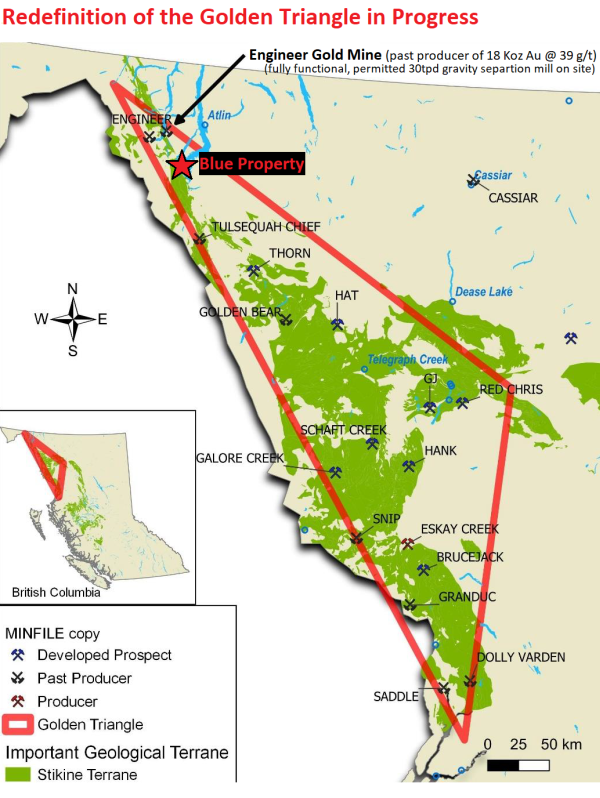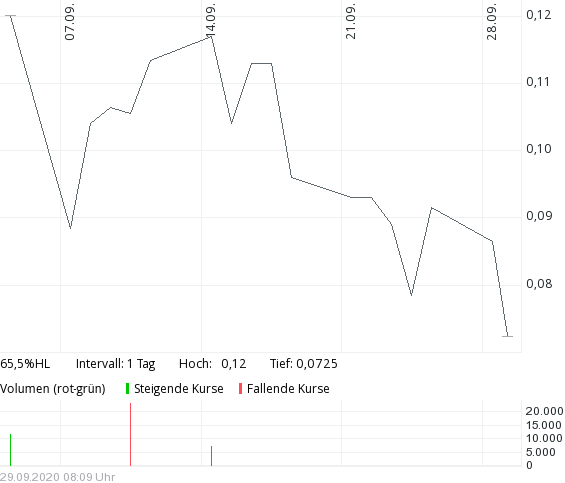Disseminated on behalf of Core Assets Corp. and Zimtu Capital Corp.
Core Assets Corp. believes to be onto something big. And there‘s good reason to believe so: The Llewelyn Fault Zone (LFZ) runs through the company‘s recently vastly expanded property (now 148 km2) located in the Atlin Mining District of northwestern British Columbia (BC). The world-class porphyry-related copper-gold deposits in BC‘s prolific Golden Triangle typically share a highly important characteristic: Structure, such as a major fault zone acting as a plumbing system for a metal-enriched feeder zone at depth. With geophysics and subsequent drilling, Core Assets aims to make a major discovery by confirming the LFZ to be the main transport corridor for high-grade metals found on the property at surface.
As announced today by Core Assets, the company has initiated the permitting process for drilling. Before the drills can start, property-wide magnetic and radiometric geophysical survey (1,100 line-km) is planned “to add new layers to delineate secondary and tertiary structures associated with mineralization and alteration found around the LFZ“. In other words, the airborne geophysical survey is done to refine the precise locations of drill targets.
CEO David Hodge commented in today‘s news-release: ”The execution of a state-of-the-art geophysical survey will help us upgrade our precision for drill placement. We believe that it is important to understand the alteration associated with deep seated secondary and tertiary structures that are fed by the Llewelyn Fault Zone. The Llewelyn Fault Zone exhibits characteristics of other prolific mining and exploration camps to the south, and we believe that it has the potential to be associated with a district scale plumbing system on our property. This survey will be yet another very important steppingstone in adding new geological layers that will help our highly experienced technical team lead us to discovery.”
In a video news-release, published shortly after the news itself, some of the Core Assets team members are interviewed by Colton Griffith (Digital Marketing Specialist at Zimtu Capital) to further discuss the significance of today‘s news:
Click on above video-player or here to watch the video news-release by Core Assets’ team members Dave Hodge (President), Scott Rose (Director), and Nick Rodway (Director, P.Geo.).
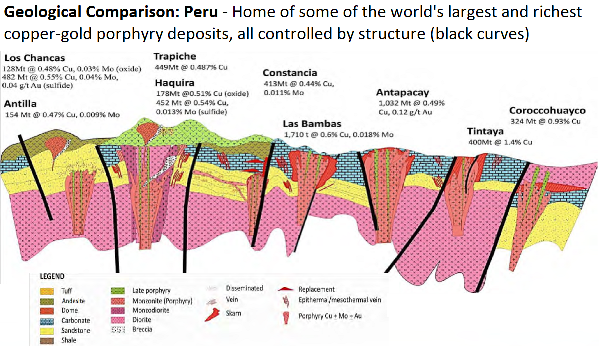
Full size / Porphyry deposits are held accountable for the world’s largest source of copper mined today and are generally the lowest unit-cost mines due to their large size. Porphyry-related deposits are well understood and typically form in similar geological settings, which makes it easier to delineate areas of interest in a cost-effective manner. There is a global proven track record in finding more than one porphyry system in a single geological area. There are numerous world-class porphyry-style deposits already located in the Pacific western margin of Canada. Porphyry exploration projects have seen the most capital raised of any deposit type in BC in the past year.
Core Assets believes that the south Atlin Lake area and the LFZ, which runs approximately 140 km from the Yukon border to the Juneau Ice Sheet in the United States, has been neglected since the last major exploration campaigns in the 1970s.
The LFZ runs directly through Core Assets‘ property and is thought to be the main transport corridor for the mobilization and concentration of high-grade metals seen at surface on the property.
The last 50 years have seen incremental advancements in the understanding of porphyry, skarn and carbonate replacement type deposits both globally and in the Golden Triangle area, with new discoveries being made annually. The sum of this knowledge is now coming together in discrete and effective exploration models that Core Assets believes could drive a major discovery. Core Assets intends to leverage this shift in understanding and become one of the most extensive explorers in the northernmost extent of the Golden Triangle saga.
The Core Assets team has significant experience and knowledge in the Atlin Mining District. They have studied the entirety of the south Atlin Lake, where there is an opportunity for world-class discoveries and mine development.
Highlights from today‘s news-release:
• “Core Assets has added 10 new diamond drill holes to a historically permitted diamond drilling program of 8 holes that the vendor had on the property, for a total of 18, targeting newly identified chargeability targets outlined by the 2019 IP survey and compilation of historic electro magnetic survey on the western part of the property.
• “The execution of a property wide magnetic and radiometric geophysical survey will add new layers to delineate secondary and tertiary structures associated with mineralization and alteration found around the Llewelyn Fault Zone (LFZ). The LFZ is a major regional fault in the Atlin area, running from the Yukon, south 140 km’s to the British Columbia-Alaska border.
• “The Blue Property hosts a historical diamond drill hole* that assayed 173.2 meters of 0.27% Cu from surface, 1.60% Cu from 173.2-179.2 meters,1.40% Cu from 186.2–194.0 meters and is open in all directions.
• “The Silver Lime Property hosts massive sulfide at surface with historical channel samples* of 3.3 g/t Au, 2,641 g/t Ag, 0.15% Cu, 2.5% Pb and 3.32% Zn, 2.56% Sb over 2.2 meters and has never been drilled to date.
• “The geophysical survey is planned to start in late October and drilling is estimated to begin in Spring 2021.“
*Historical numbers are provided as an indication that mineralization is present, and is relied on by the Company as encouraging further exploration and assessment of the properties.

Full size / Select exploration, development and mining projects in the “Golden Triangles“ of British Columbia (Greens Creek Mine located in Alaska). Above stated numbers may be rounded, from companies‘ public disclosure (Koz = thousand ounces; Moz = million ounces; Blb = billion pounds; Eq = Equivalent; M+I = Measured & Indicated Resources; P+P = Proven & Probable Reserves). Note that results of above stated past producers, active mines, exploration and development projects in the region are not necessarily indicative of the potential of the Blue Property and should not be understood or interpreted to mean that similar results will be obtained from the Blue Property. The historical information in reference to the drill hole (1973) on the Blue Property from Core Assets Corp. is relevant only as an indication that some mineralization occurs on the Blue Property, and no resources, reserve or estimate is inferred. A qualified person has not done sufficient work to classify the historical information as current mineral resources or mineral reserves; and neither Rockstone nor Core Assets Corp. is treating the historical information as current mineral resources or mineral reserves.
The following sections about the Blue and Silver Lime Projects are also from Core Assets‘ news-release today:
Blue Property
“In 2018, the Company sent a geological team to the Blue property for preliminary surface sampling. The field crew observed three areas of skarn exposure with massive and disseminated visible sulfide along the western side of the Llewellyn Regional Fault Zone. 28 grab samples were taken and sent to the laboratory for geochemical analysis and returned values of up to 1.57 g/t gold, 46.5 g/t silver and 8.46% copper.
“In 2019, Core Assets contracted Aurora Geosciences Ltd. for the execution of an induced polarization geophysical survey over the areas of high priority mineralization which confirmed and highlighted areas of elevated chargeability response over visible skarns and identified multiple chargeable porphyry style targets.
“Later in 2019, Nick Rodway, P. Geo. (Director of Core Assets Corp.) and Matthew Carter (Qualified Person of Dahrouge Geological Consulting Ltd.) visited the property to reanalyze some of the high priority areas identified by the 2018 and 2019 programs. The program successfully confirmed elevated gold, silver and copper values.
“The amalgamation of Core Asset’s newly obtained geological information, and the historical exploration data, including the 1973 exploration program undertaken by Rio Plata Silver Mines Ltd., where a single diamond drill hole “assayed 173.2 meters of 0.27% Cu from surface, 1.60% Cu from 173.2-179.2 meters and 1.40% Cu from 186.2–194.0 meters will serve as a bases to complete further structural analysis for placement of drill holes. This could potentially lead to a new porphyry style discovery in British Columbia.“
Silver Lime Property
“The Silver Lime Property is located just 10 km west of the Blue Property (now contiguous) and was originally acquired by Core Assets as a secondary project. Through rigorous desktop geological study by Core Assets’ technical team, it has been deemed that the same exploration model revolving around fluid mobilization of the Llewellyn Fault Zone also applies to the west.
“Historically, the Silver Lime Property consisted of two significant mineral occurrences known as the Falcon and Jackie showings. The Falcon showing was discovered by Carmac Resources in 1990 and consists of two northwest trending quartz veins. Mineralization comprises galena, sphalerite, pyrite, chalcopyrite, arsenopyrite and stibnite. The vein system is exposed for 25 meters and the strike extensions are covered by talus. Individual veins are up to 1.2 meters wide.
“To the northwest, a quartz-feldspar porphyry breccia contains smaller quartz veins with semi-massive arsenopyrite and stibnite. A 2.20 meter wide sample* of the vein system assayed 3.3 g/t gold, 2,641 g/t silver, 0.15% copper, 2.5% lead and 3.32% zinc, 5.0% arsenic and 2.56% antimony (Assessment Report 21162 ).
“In 2018, Zimtu Capital Corp., as part of a helicopter reconnaissance program, prospected the property taking 8 samples. The results confirmed the program that Carmac did in 1990, returning values reaching 1.16 g/t gold, 913 g/t silver, 12.45% zinc and >20.0% lead.
“The Silver Lime Property potentially fits a carbonate replacement deposit model (CRD). Massive sulphide pods occur in limestone and biotite-muscovite-sericite schists generally near the contacts between the units. Large zones of limonite alteration, cut by alaskite and hornblende porphyry dikes, usually surround the pods. The lenses appear to be widest near the dikes. Several faults follow the general direction of the dikes, suggesting structural control on the mineralization. Sulphides comprise galena, sphalerite chalcopyrite, pyrrhotite and pyrite. The pods are up to 30 meters long and 6 meters wide. The smaller pods host sphalerite and galena mineralization and the larger pods vary mineralogically along length. Galena, quartz and calcite dominate the northwest changing to pyrrhotite, chalcopyrite and pyrite in the centre and border areas (Minfile 104M 031).“
NI 43-101 Disclosure: Nicholas Rodway, P.Geo, is a Director of the company, shareholder and qualified person as defined by National Instrument 43-101. Mr. Rodway supervised the preparation of the technical information in this news release.
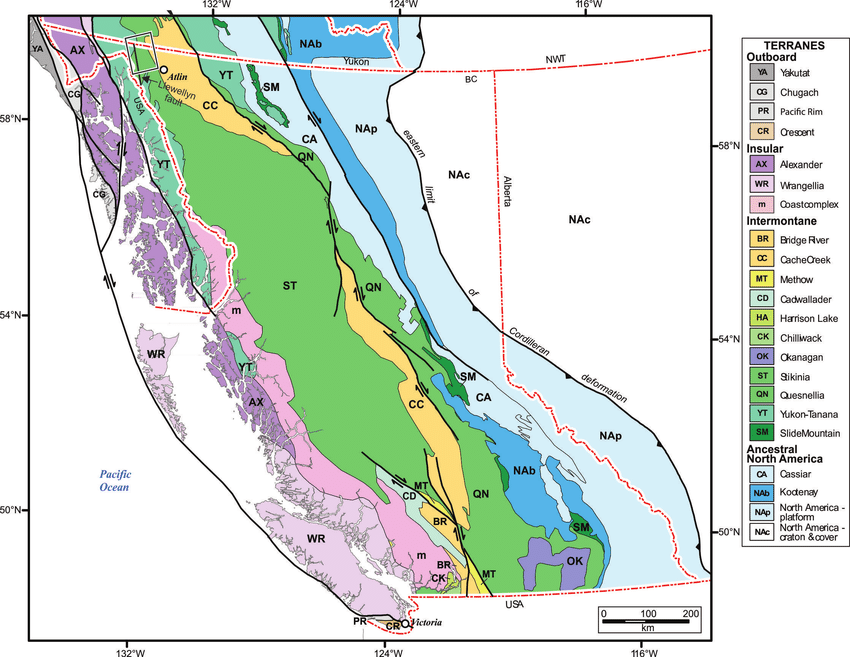
Full size / Geological terrane map of British Columbia and neighbouring jurisdictions. In 2017, the BC Geological Survey studied the area in northwestern BC (highlighted by a black outline), just a few km north of where Core Assets’ Blue Property is located. In its preliminary report, the following was noted by the authors: “The Llewellyn fault represents a signiï¬cant geological feature in northwest British Columbia. The fault is at least 100 km long, northwest striking, and steeply dipping... Spatially related to the fault are quartz-carbonate vein-hosted gold-silver and base-metal prospects, including the past-producing Engineer mine... The spatial relationship between the Llewelyn fault and vein-hosted mineralization supports a structural link, and geochronological data indicate a temporal link between gold mineralization (Engineer and Mount Skukum mines) and Eocene volcanism... The apparent relationship between structure, mineralization and magmatism points to the intrusion-related, epizonal, end-member of the orogenic gold deposit model because such deposits are typically related to ï¬rst-order crustal breaks and synchronous magmatism... South of Atlin Lake, the Llewellyn fault may merge with the southeast striking King Salmon thrust fault...” (Above figure modified after Nelson et al., 2013; Source: “Testing the relationship between the Llewellyn fault, gold mineralization, and Eocene volcanism in northwest British Columbia”, British Columbia Geological Survey, 2017)
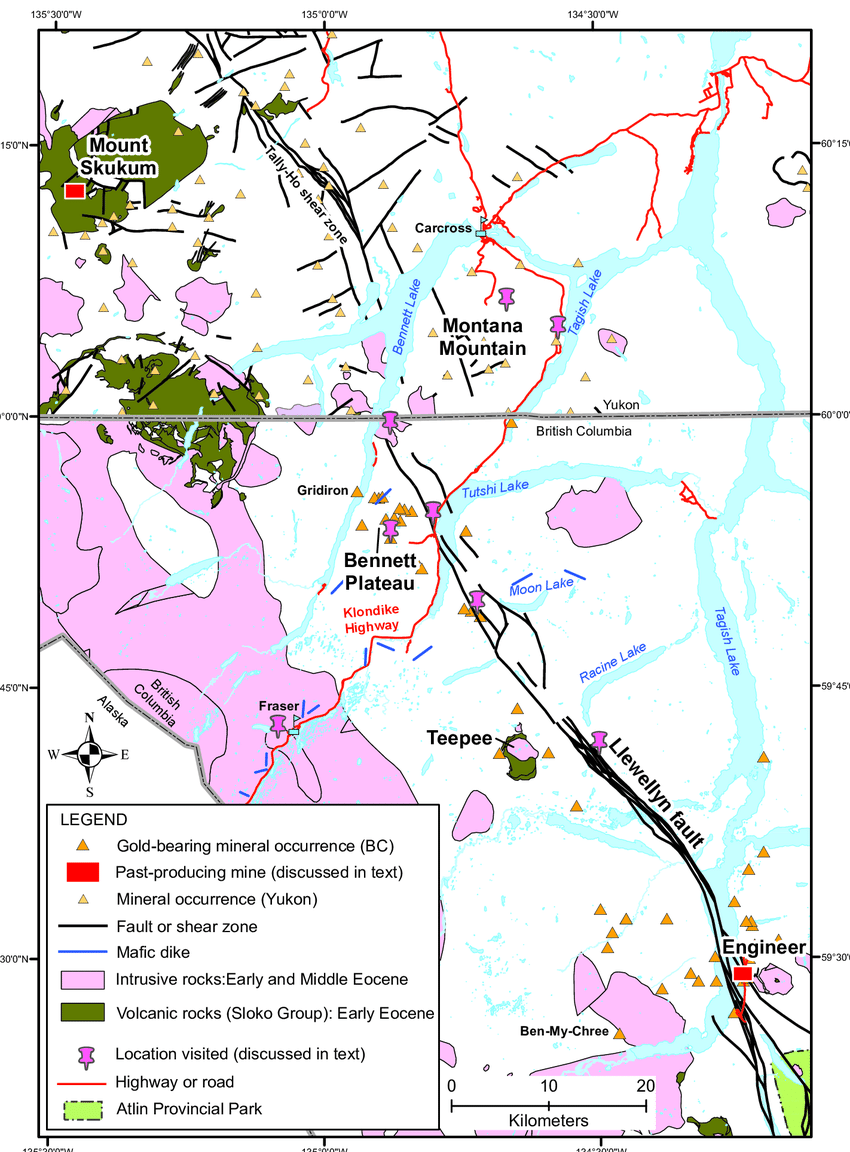
Full size / Simplified geology (Eocene rock units only) near the Llewellyn fault, northwest British Columbia as shown in the preliminary report by the BC Geological Survey (2017) noting the following: “More than 50 mineral occurrences spatially related to the Llewellyn fault have been documented in the study area... Many of these deposits and prospects have been known for more than 100 years, following discoveries during the Klondike gold rush of the late 1890s. Not surprisingly, these occurrences are in clusters near road and rail routes and water access sites at Bennett and Tutshi lakes in the northwest, and Tagish Lake in the southeast. Three past-producing vein-hosted precious and base-metal deposits are in the British Columbia part of the study area. The Engineer Mine was the most productive gold deposit... Gold has been mined intermittently at the Engineer Mine for more than 90 years. BCGold Corp. reported a NI 43-101-compliant Inferred Mineral Resource of about 41,000 tonnes grading 19.0 g/t of total contained gold (5 g/t cut-off grade; Dominy and Platten, 2011).” (Above figure after Doherty and Hart, 1988; Mihalynuk et al., 1999; Source: “Testing the relationship between the Llewellyn fault, gold mineralization, and Eocene volcanism in northwest British Columbia”, British Columbia Geological Survey, 2017)
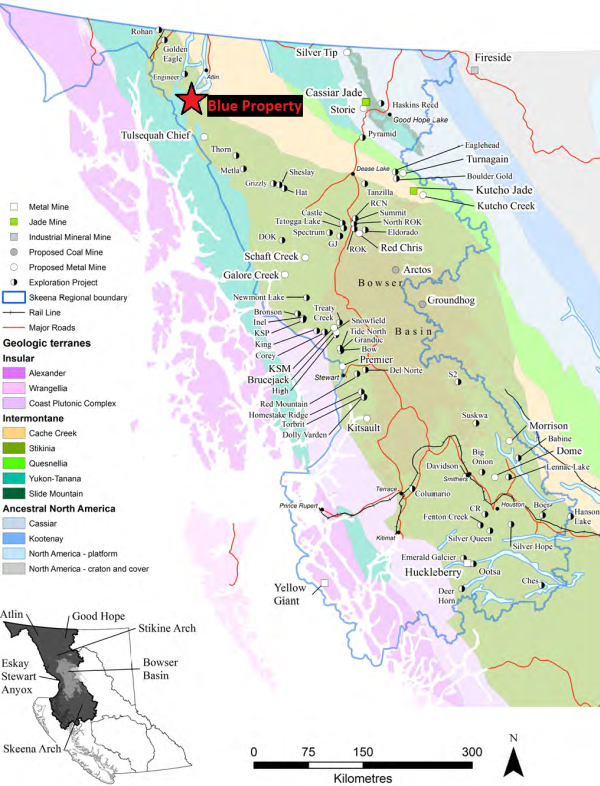
Full size / Active mining and exploration projects Skeen Region, 2014 (Blue Property added by Rockstone) Source: Kyba, J., 2015. Exploration and mining in the Skeena Region, British Columbia. In: Exploration and Mining in British Columbia, 2014. British Columbia Ministry of Energy and Mines, British Columbia Geological Survey, Information Circular 2015-2, pp. 97-114
Previous Rockstone Coverage
Report 2: “On a Mission to Become the Premier Copper-Gold Porphyry Explorer of the Northernmost Extent of the Golden Triangle“ (Web Version / PDF)
Report 1: “Perfect Time to Reshape the Golden Triangle in British Columbia“ (Web Version / PDF)
Company Details

Core Assets Corp.
Suite 1450 – 789 West Pender Street
Vancouver, BC, V6C 1H2 Canada
Phone: +1 604 681 1568
Email: info@coreassetscorp.com
www.coreassetscorp.com
Incorporation Date: April 20, 2016
Listing Date: July 27, 2020
CUSIP: 21871U05
ISIN: CA21871U1057
Shares Issued & Outstanding: 21,216,000
Canadian Symbol (CSE): CC
Current Price: $0.13 CAD (09/28/2020)
Market Capitalization: $2.8 Million CAD
German Symbol / WKN: 5RJ / A2QCCU
Current Price: €0.0725 (09/29/2020)
Market Capitalization: €1.5 Million EUR
Contact:
Rockstone Research
Stephan Bogner (Dipl. Kfm.)
8260 Stein am Rhein, Switzerland
Phone: +41-44-5862323
Email: info@rockstone-research.com
www.rockstone-research.com
Disclaimer: This report contains forward-looking information or forward-looking statements (collectively "forward-looking information") within the meaning of applicable securities laws. Forward-looking information is typically identified by words such as: "believe", "expect", "anticipate", "intend", "estimate", "potentially" and similar expressions, or are those, which, by their nature, refer to future events. Rockstone Research, Core Assets Corp. and Zimtu Capital Corp. caution investors that any forward-looking information provided herein is not a guarantee of future results or performance, and that actual results may differ materially from those in forward-looking information as a result of various factors. The reader is referred to Core Assets Corp.´s public filings for a more complete discussion of such risk factors and their potential effects which may be accessed through its profile on SEDAR at www.sedar.com. Please read the full disclaimer within the full research report as a PDF (here) as fundamental risks and conflicts of interest exist. The author, Stephan Bogner, holds an equity position in Core Assets Corp.,as well as in Zimtu Capital Corp., and is being paid by Zimtu Capital Corp. for the preparation, publication and distribution of this report, whereas Zimtu Capital Corp. also holds a long position in Core Assets Corp. Note that Core Assets Corp. pays Zimtu Capital Corp. to provide this report and other investor awareness services. Zimtu Capital Corp. is an insider and control block of Core Assets Corp. by virtue of owning more than 20% of Core’s outstanding stock. Core Assets Corp. has one or more common directors with Zimtu Capital Corp. The cover picture (amended) has been obtained and licenced from wacomka.


